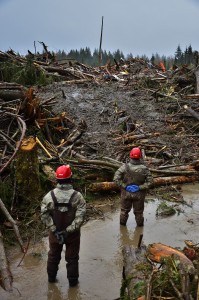The Stillaguamish Tribe is fighting off suggestions by the state Attorney General’s Office that it might face liability for the devastating Oso landslide, which wiped out a rural neighborhood and killed 43 people in 2014.
In a lawsuit filed in U.S. District Court in Seattle last week, the tribe said the state has been sending letters arguing the tribe could face liability because of work it performed along the Stillaguamish River where the hillside gave way. The tribe is seeking a ruling from the court that would protect it from having to pay.
Thirty-nine victims, victims’ estates and residents whose property was damaged have sued the state, Snohomish County and logging company Grandy Lake Forest Associates over the landslide. A three-day mediation session this past week – held just after a judge on Monday seriously limited the plaintiffs’ case – failed to yield a settlement.
The state is seeking to have the tribe or its insurers assume at least some of the responsibility for any payout, the tribe said in its complaint. In a letter June 9, the state cited $12 million as a conservative estimate of the amount of damages potentially due to the plaintiffs, the complaint said.
The dispute over the possible liability stems from work the tribe performed to improve salmon habitat by installing a “crib wall” to help control sediment in that part of the river. The work was done with the help of a $497,000 grant from the state.
The Attorney General’s Office declined to comment on the lawsuit. But according to the tribe, the state is claiming that in the agreement for the funding, the tribe waived its sovereign immunity from lawsuits and said it would indemnify the state against any lawsuits arising from its work.
The Stillaguamish disagree, saying that Pat Stevenson, the tribe’s environmental manager, had no authority to sign the deal and that even if he had, the waiver of sovereign immunity would only apply to lawsuits brought by the state to enforce the funding agreement – not lawsuits from third parties.
“The Tribe’s official records demonstrate that the Tribe’s Board of Directors passed no resolution delegating authority to anyone to sign the Agreement on the Tribe’s behalf,” the complaint says. “There is no evidence of the Board ever considering the Agreement at all. Without a Board resolution approving the Agreement or authorizing anyone to sign it on the Tribe’s behalf … the Tribe could not have waived its inherent sovereign immunity for claims arising out of the Agreement.”

The landslide occurred on March 22, 2014, when the river undercut a hillside soaked with heavy winter rains. The plaintiffs have argued that county officials knew about the landslide danger, based partly on a 1999 study that warned of potential catastrophe – if not a disaster approaching the magnitude of the 2014 slide. While Snohomish County held a public meeting for local residents in 2006 to advise them about landslide and flooding dangers, it didn’t make clear how dire the risk was, they argue.
They have also argued that logging at the top of the slope may have increased the landslide risk.
The defendants have argued that they did nothing to increase the danger of a landslide.
King County Superior Court Judge Roger Rogoff last Monday limited the plaintiffs’ case against Snohomish County and the state. He ruled that while Snohomish County had no legal duty to warn anyone about the danger, once it voluntarily did so, at the 2006 meeting, it had an obligation to do so responsibly – that is, to provide the information in a way that did not make the residents’ situation worse, such as by suggesting they were safe or giving a false sense of security. Taking the plaintiffs’ evidence as true, he said, the government’s actions may have been negligent.
But only those plaintiffs who were aware of what was said at the meeting and relied on that information have viable claims, the judge ruled. Attorneys for Snohomish County have argued that just a handful of the plaintiffs or victims in the case attended the meeting or learned of what was presented during it.
Was this article valuable?
Here are more articles you may enjoy.

 Merck Faces Patent Lawsuit Over Easier-to-Use Keytruda
Merck Faces Patent Lawsuit Over Easier-to-Use Keytruda  Forecast Calls for Wildfires to Burn More Land Across U.S. This Year
Forecast Calls for Wildfires to Burn More Land Across U.S. This Year  Audi Q6, Three Other Vehicles Earn IIHS 2025 Safety Awards
Audi Q6, Three Other Vehicles Earn IIHS 2025 Safety Awards  Survey Shows Distracted Drivers Overconfident: 20% Text While Driving, 15% Use Social Media
Survey Shows Distracted Drivers Overconfident: 20% Text While Driving, 15% Use Social Media 